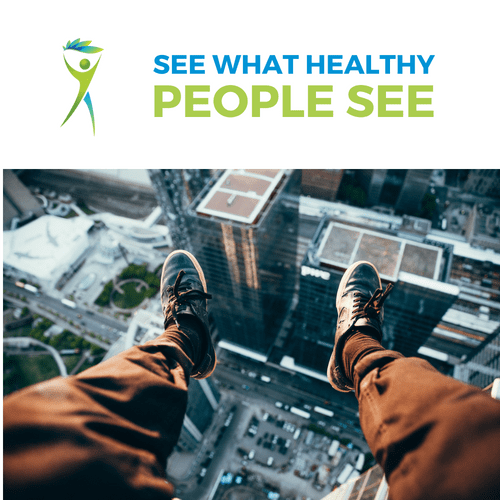
25 Jun See What Healthy People See: How the Stages of Change Give You a Map To Health
Doctor’s Note: This post is long. I recommend that only those who are deeply wanting to understand human psychology or who have a strong desire to change something in their lives read it.
I’ve become obsessed with:
- Perspective: seeing the world through different eyeballs and in different shoes. (3 Frames to Visualize Success)
- Measuring Progress: using stages of change to hit milestones for getting what I want
The question I ask myself is:
How do you cultivate perspective so that you can set goals and achieve them with ease?
Once you see what Mark Zuckerberg sees, you can create Facebook.
Once you see the world the way Jesus did, you can heal by pointing my finger. (I’m not Christian, but I do believe in Jesus, the person and healer.)
Once you see what Donald Trump sees, you can understand why he makes decisions that you or I don’t currently understand.
Perspective is vision.
If you can’t see that the path in front of you leads to your promise land, where all of the people who have solved your problem hang out and dance around in child-like giddiness, then you’re constantly questioning what you’re doing.
Imagine having a map with directions, detours, obstacles, and precise instructions leading towards where you want to go.
Perspective is the vision that lets you see the map.
The map begins with understanding your mind and how change happens.
Stages of Change and The Power Of Your Mind

Americans are buried in information and knowledge (What is unknown is the #1 cause of annoying pain that hasn’t gone away in more than two months. Removing adhesion is why we exist at Barefoot Rehab. The reason why the American population is unaware of this knowledge is because adhesion removal is an innovation in manual therapy and did not exist 30 years ago.).
If it were only about knowledge, Americans would all be billionaires with six-pack abs.
Knowledge isn’t good enough.
Pain and disease isn’t a knowledge problem.
Pain and disease is a behavioral psychology problem.
The more you know about your own mind and how it works, the more you can navigate guaranteeing your health and success in the rest of your life.
The stages of change are milestones on the path towards getting what you want so that you can check in on where you are.
Recovering perfectionists (surprisingly, this characterizes many of the people I know) like myself learn to focus on progress. The stages of change allow you to focus on progress when you really want to a make a health change happen.
There are 6 stages of change mentioned in the book Changing for Good.
Pick your #1 desired health/fitness change and ask yourself which stage of change you’re in.
Consider what the alcoholic might go through.
1. Pre-Contemplation (“I can’t …”)
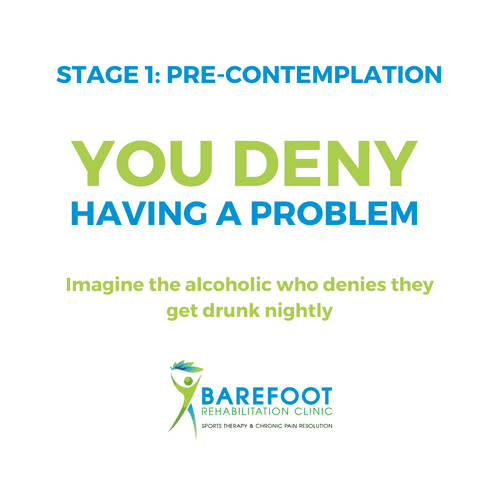
You’re unaware of a problem.
You deny having a problem. Imagine the alcoholic who wants to keep drinking.
You resist the change and avoid talking about it if it’s brought up, often getting emotionally triggered by conversations meant to help you.
You feel hopeless and that change will never happen.
2. Contemplation (“I may …”)
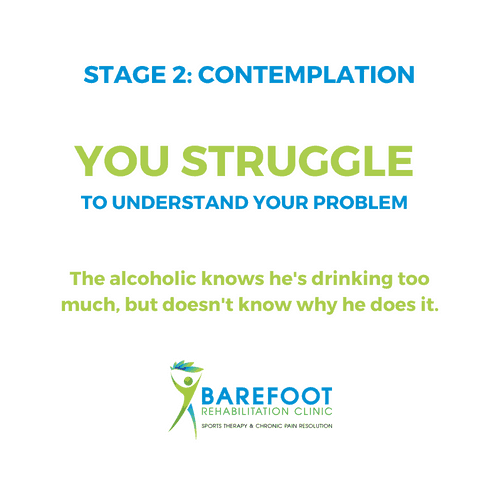
You want to stop feeling so stuck.
You now know you have a problem, but you struggle to understand your problem.
You’ve begun to plan action towards solving your problem, even though you’re not committed or ready to take action yet.
You’re scared to fail and feel stuck.
You’re mind is tired of thinking about your problem.
You’re almost out of this stage of change when you’ve begun to anticipate and feel excited.
3. Preparation (“I will …”)
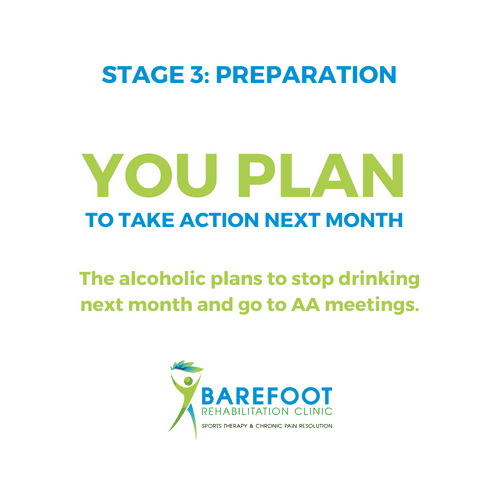
You’re planning to take action in the next month.
You may have made your choice public so introduce accountability from those who care about you.
You may still need some convincing.
4. Action (“I am …”)
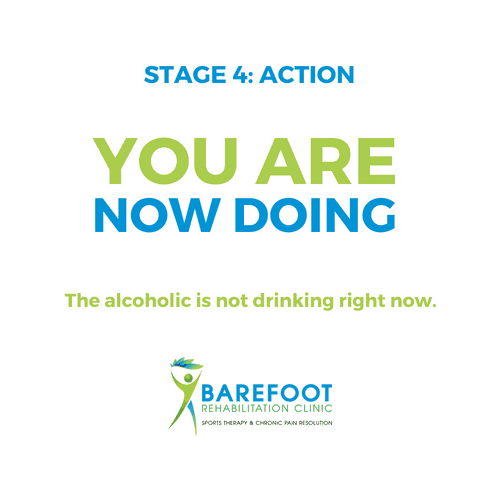
You’ve started doing and become mindful of your environment.
You’ve noticed that this stage of change requires the greatest amount of your time and energy.
People are started to notice that you’re acting differently.
You’re thinking about the future and how you’re going to maintain the changes.
5. Maintenance (“I am still …”)
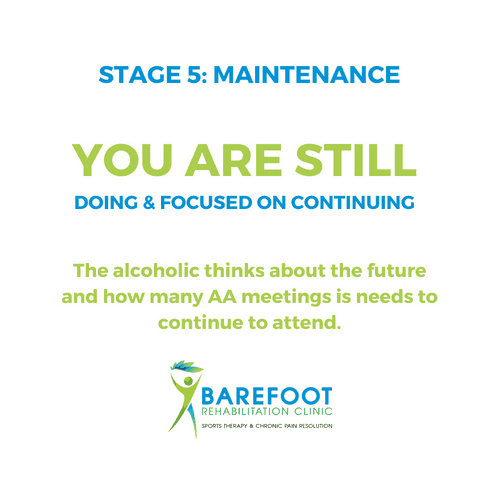
Your energy is no longer going towards the changes in your behavior but continuing to perform those actions.
This stage can last as long as your lifetime.
6. Termination (“I have …”)
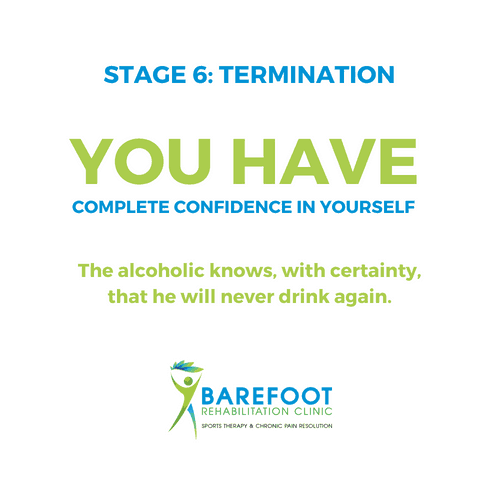
This is your desired end goal.
You are here when you have complete confidence in your behavior that you will not relapse.
—
Those are the 6 stages of change.
Where are you with your #1 desired health/fitness goal?
What steps can you take to get from the stage of change you’re at to the next one?
Start Cultivating Perspective: “I wish I stopped smoking.”
Only a fool learns from his own mistakes. The wise man learns from the mistakes of others. ~Otto von Bismarck
So far, we’ve discussed you.
Sometimes, it can be hard to see our own situation from behind our own eyeballs. We often have an easier time talking to and helping someone else than we do for ourselves.
That’s why it’s ridiculously impactful to observe other people who have succeeded or failed with the same problem that you have.
Two weeks ago, I asked the Barefoot Rehab email list a question.
I wanted to know:
How do you think about your health, zoomed out across your entire lifespan?
Specifically, how would you feel about your life if it had been 1 month after you passed away and you had the opportunity to look back at your life?
Below is a person on our email list who has two desired health changes: quitting smoking and starting kata (a form of karate). My initial email is in black. Her response is in blue.
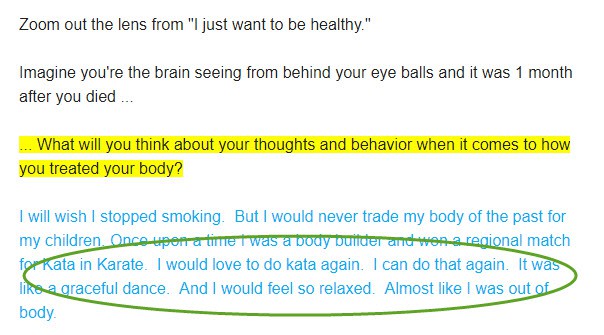
I wish I stopped smoking … Once upon a time, I was a body-builder and wont a regional match for kata in karate. I would love to do kata again. I can do that again. It was like a grateful dance. And I would feel so relaxed. Almost like I was out of body.
This woman has a desire to stop smoking, but hasn’t yet. She is in Stage #2: Contemplation.
It sounds like the reason she hasn’t progressed to Stage #3: Preparation yet is that the desire isn’t strong enough, yet.
Then, Lisa discusses how kata helped make her feel really relaxed in the past.
She states she would love to do kata again and that she knows she can do it again.
Interestingly, she hasn’t started doing kata yet either.
It makes you wonder, how badly does this woman want to feel relaxed (by doing kata)?
Can you see any of yourself in this woman’s words?
What perspective can you take from her that you can use for your desired change?
When it comes to health, perspective of how others achieve pain and disease-free living helps us know what changes we can make.
The rest of this post will offer our patients’ perspectives and how they’re able to create health for themselves and their families.
Cultivating Perspective: What Our Patients Had to Say
When you put yourself in the shoes of another person, you gain valuable information about what they feel, say, and do.
Then, you can re-orient yourself.
Awareness of others and self-awareness is the pathway towards getting what you want.
Without perspective of what has worked or what hasn’t worked, how can we expect to know where the obstacles are on the path or if a path truly leads to where we think it’s going?
For anyone reading this now on this blog about fixing pain and living pain-free, awareness means:
- waking up and going to sleep each day, without pain.
- having health that you don’t have to worry about because your habits are aligned with the habits of others who are thriving in health.
- experiencing joy, daily, so that you can make the most of your time on this dirt-rock called Earth.
The responses from our Barefoot Rehab email list were telling, as always.
First, our patients who were the jokesters in high school responded.
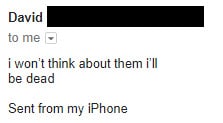
We had people whose religion seemed to dictate their lifestyle choices now.
IMPORTANT NOTE: Please, check yourself before making any judgments. It’s very important that we maintain a perspective of compassion and tolerance, where all perspectives and ways of living are welcome. This is the only path to ending all types of violence. Click for more on ahimsa or non-violence.

Then, we started to dig into the psychology of how people see the world to pull out the golden nuggets of perspective.
You can thank the patients of Barefoot Rehab.
Golden Perspective #1: The Traditional Medicine Profession Has Left Us Disappointed – Be Your Own Advocate
The highlights are mine.

In general, the traditional medical profession has left us disappointed.
Loss of faith in our healthcare and insurance system is a common denominator perspective for most of the patients who come into our office.
It’s the reason why most patients don’t come through our clinic’s doors until they’ve tried 3-5 other doctors. They need to be frustrated with conventional options before seeking out a therapy that isn’t mainstream, but extremely effective.
It surprises me, every single time, that patients have had to try a cortisone shot 2-3 times and prescriptions for steroids more than once that it’s taken them so long to learn that those interventions do nothing to fix the cause of their pain.
Is this you? How many times must you fail to fix your problem?
You always need to be your own advocate and learn how to interpret test results.
Hearing this patient’s words is music to my ears.
You’re not allowed to hand-off responsibility to any doctor or person you trust.
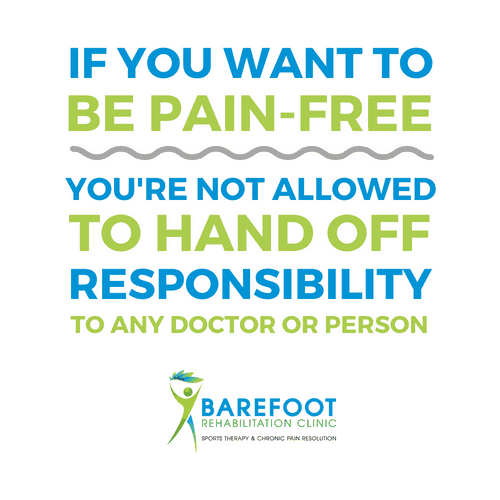
Any piece of your mind that holds on to a victim mindset leaves open the opportunity for you to be taken advantage of.
The only path towards full power is taking 100% responsibility.
99% responsibility means 1% victim-mindset.
Even a tiny dose of venom is poison to the body.
Even a tiny amount (1%) of victim-mindset is poison to the mind.
Especially when it comes to your health, you must be your own advocate.
Do you hand off responsibility?
Are you expecting a loved one or a doctor to make all decisions for you?
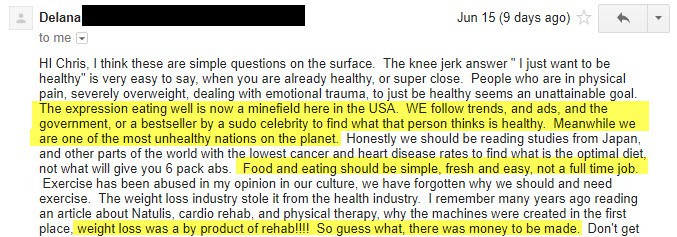
The expression eating well is now a minefield here in the USA. WE follow trends, and ads, and the government, or a bestseller by a pseudo celebrity to find what that person thinks is healthy. Meanwhile we are one of the most unhealthy nations on the planet … Food and eating should be simple, fresh and easy, not a full time job.
Delana observes the danger (using the word “minefield”) of something that should be apparently simple, the substance we put into our mouth that become the cells of our body.
The hard part about diet (defined as “what you eat”) is figuring out what works for you and keeps your body lean, with high energy, and minimal risk of disease now and in the future.
Once that is figured out, the simple part is sticking to it.
I workout 10% as much as I used to and have been told for years “how lean I look”. I’m fascinated that I’m continually told this because of my low frequency of workouts.
Digging down, I’ve realized that my results occur because I stick to the food rules I’ve discovered that work for me.
- Intermittent Fasting: Almost everyday, I’ll drink coffee with butter and MCT oil for breakfast around 7 AM. I eat my first meal between 12-2 PM and my last meal no later than 8 PM, reducing my eating window to 8 hours and increasing my fasting window to 16 hours, resulting in less calories consumed and more time for my body to work on non-digestive processes.
- No Prep/Buy Cheat Foods: When I prepare foods, it’s always vegetables, animal meat, and nuts/seeds. I don’t allow myself to make or buy any pastas, desserts, dairy, or sugar.
- “When in Rome …”: At parties or celebrations, I eat cookies, cake, ice cream, and anything else you might put in front of me. The cost gets paid for splurging anywhere from minutes to 72 hours after that food’s consumption when my mind stops working and I get diarrhea or immense bloating.
- One Splurge Every 72 Hours: If the opportunity comes to splurge on two pig-outs within a few days of each other, I pass. My mind quickly sets into depression when I go here, so I don’t go anymore.
Have you been ignoring your body’s signs? Can you create simple food rules that you can follow on a daily basis?
Weight loss was a by-product of rehab!!!! So guess what, there was money to be made.
Delana makes this observation, correlating the failing healthcare system with businesses seeking to increase revenue.
The U.S. is a capitalistic society.
The beautiful thing about a capitalistic society is that consumers vote with their dollars.
The saddening thing is that discernment (defined as “the ability to judge well”) is necessary to observe where an individual or business is looking to make a dollar instead of actually serving the people they serve.
Develop the skill of discernment in various ways:
- Talk to the people in your personal network about how they solved a specific health problem.
- Use social media to ask your online network how they solved their problems.
- Google it: To help consumers from being taken advantage of, there’s this powerful tool called Google that allows us to do research beforehand. I’ve been known to be a smart-ass when people ask me questions like, “How do I make your vegetable soup? It’s so good!” I respond, “I don’t remember, but you know who does? Google.”
Step back and become mindful of the people who have solved your problem or not. What lessons can you tease out from their process?

When a problem arises is to always go to the Dr., after you know what the problem is you can choose to take their advice or try something else, but without knowing you are just kicking the issue down the lane until it becomes bigger and harder to manage.
Remember, if it were only about knowledge, all Americans would have yachts and instagram pages with our faces on a model’s body.
Knowledge is only power when you know how to use that knowledge.
With the skill-sets you’re learning today, you get on path to billions of dollars and 6-pack abs.
The patient above is collecting knowledge from an expert doctor. The doctor may not always be right, but at least you’re utilizing their expertise by getting a diagnosis.
Treatment or any behavior pointed at fixing your problem is useless without a diagnosis.
Remember, knowledge (or data) is good because you’ll have already been practicing how to discern.
At Barefoot Rehab, when faced between the choice of more or less data, we often resort to MORE data.
If nothing else, we won’t be able to use the data and we’ll put it to the side. But sometimes, a little piece of data can mean the difference between wasting thousands of dollars and months worths of time or not.
A few years ago, a CrossFitting dad in his 50’s came to see me for elbow pain. He couldn’t get his wrist closer than 3.75″ to his deltoid. His pain responded well to the removal of adhesion from his brachialis and deep tricep so that he could continue performing cleans and front squats, but his range of motion did not change. We decided to get an MRI. The results came back with severe cartilage degeneration.
The path forward was clear.
No more CrossFit (or front rack positions) for you.
He understood that pain-free longevity was more important than the intensity of his current workouts.
Without that data, he could’ve continued CrossFitting and further degenerating that elbow cartilage to the point of untreatable pain.
Is there an expert who claims to solve your problem you can talk to?
If you’ve been looking for an expert who specializes in fixing annoying, frustrating pains, even when you’ve had it more than 2 months and you’ve seen 3-5 other doctors or therapists (wink wink), comment below with your problem. : )
Golden Perspective #2: Listen to the Cues

I listen to my body cues and adjust my intensity from extreme to casual. Whether I’m competing or walking through the woods, I always blend fitness with my life.
Pain is a cue from the body, kind of like the fire alarm when there’s a fire.
It tells us when you’re overusing a specific tissue in the body.
If what you’re doing causes pain, you have choices if you value your health:
- Lower the intensity without trying to fix your pain and keep doing your activity.
- Lower the intensity with trying to fix your pain and keep doing your activity.
- Ignore the cue, keep doing your activity, and hurt yourself more until you’ve permanently damaged your body, finally being forced to stop doing your activity.
With awareness and “listening to your body’s cues”, you can continue blending fitness into your life.
So many people ignore their body’s pain and continue performing the offending activity.
Are you ignoring your body’s cues? Please, be careful.
Golden Perspective #3: Maintain Baseline of Fitness

When it comes to exercise I pretty much do whatever maximizes my performance in the activities I like to do … I maintain a baseline of fitness so that if I do something spontaneous and strenuous I don’t get hurt and it does not take long to recover. I know that a lot of people hurt themselves doing ordinary activities like lifting furniture or doing yard work because they have basically zero conditioning.
Life has a way of handing us things that test us.
If you aren’t prepared for what life hands you, whether it’s physical stress like Tanner observes (moving furniture or doing yard work) or emotional stress (like learning how to cope with an over-bearing boss or dealing with a partner who leaves you), you can become overwhelmed.
Maintaining a baseline level of fitness is 100% necessary so that you don’t end up hurting yourself.
One of the most painful things I experience as a pain doctor is when a patient is aging (in her 50s, 60s, or 70s) and she missed the opportunity to cultivate any fitness. With no baseline of fitness and severe degeneration in her joints from a lack of help from her muscles, she cannot even try to workout because it would cause too much pain for her.
That’s when I say to her:
There’s nothing we can do for your pain.
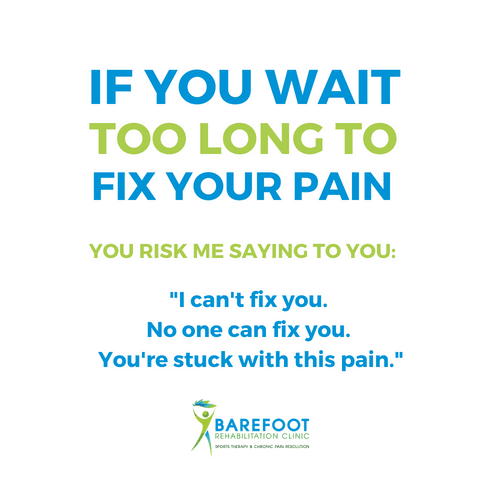
If you don’t want to exercise to look good naked, at least workout so you prevent years to decades worth of pain towards the end of your life.
For those of you who don’t workout, can you adapt the frame of utilizing the Minimal Effective Doseage (M.E.D.) and do 20 lunges and 20 push-ups (try 1 sets of 5 every hour for 4 hours)every day for the rest of your life?
That movement prescription alone would go along way.
Golden Perspective #4: Follow the Old People at the Gym

At the gym, we should be speaking to the oldest person there and find out what they do, because if you want to some day be old, follow that person, their lifestyle got them to be old and physically able to go to they gym, that is how I hope to age. Getting advice from someone 25 years younger than me can be new and perhaps cutting edge, but ultimately much of it won’t be applicable.
As a CrossFit box owner for five years, I saw young person after young person in their 20s lose weight and get fitter than they’ve ever been before … until they got hurt. Often, the injuries accumulated and became more rampant for those individuals.
Interestingly, the gym’s population, when divided by age group, was highest for 20 year-olds and went linearly down decade by decade.
Most CrossFitters won’t be CrossFitting in 30 years. In the same way that most professional athletes, Olympic lifters, or power lifters won’t be doing their activity in 30 years.
Why?
The activity is too intense to maintain over the long haul.
The financial advisor’s concept of a cost-benefit analysis shines light on the Buddhist approach to working out, or the Middle Road of Fitness.
Not too much movement or exercise, not too little.
The benefit is high with this approach. Stay lean, health, and looking good, although you won’t look like a body-builder.
The cost is low. Your joints will degenerate as slowly as possible and the risk of injury now and in the future will be as minimal as possible.
The Middle Road of Fitness is the path the oldest person in the gym took to get to where they are today.
Talking to the oldest person at your gym or doing a deathbed meditation is how you ask yourself if you’re path to being as fit as possible in old age.
Is your body continuing to express injury after injury? Are you doing too much? Is it time to back off?
On Top of the Mountain, What Do You See?
You’ve just heard from 1 person who wants change, but not badly enough to actually do it.
You’ve also heard from a handful of our patients who have solved the problem of pain and disease for themselves and their families by seeing the nuances of 4 Golden Perspectives:
- The Traditional Medicine Profession Has Left Us Disappointed – Be Your Own Advocate
- Listen to The Cues
- Maintain a Baseline of Fitness
- Follow the Old People at the Gym
The Golden Perspectives are the milestones on the map.
Ask yourself:
Do I respect each Golden perspective?
If not, why not?
With the milestones, check yourself with what desired state of change for your health/fitness you desire.
Which stage of change are you in for your #1 desired health/fitness change?
With perspective, you’re at the metaphorical top of the mountain, seeing where the start and end points on the path to health and pain-free living are.
Now, it’s a matter of walking the path.
Will you walk the path of healthy, pain-free, and fit living?
 Which Golden Perspective is most helpful to you? Can you think of another perspective that is helpful on the path towards healthy, pain-free, and fit living? Tell us about it.
Which Golden Perspective is most helpful to you? Can you think of another perspective that is helpful on the path towards healthy, pain-free, and fit living? Tell us about it.

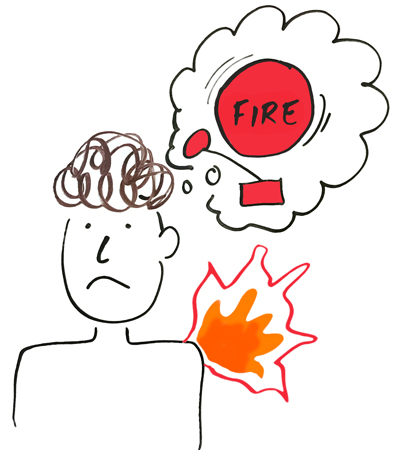
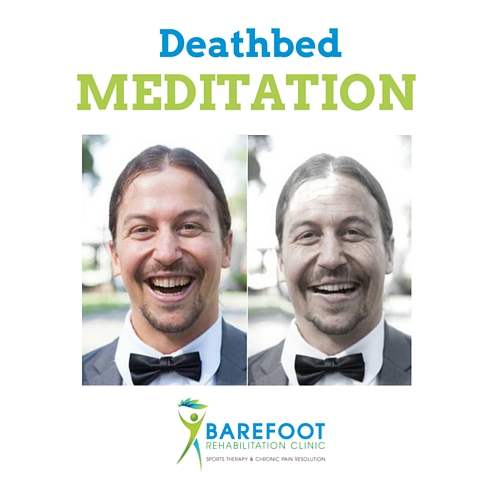
No Comments